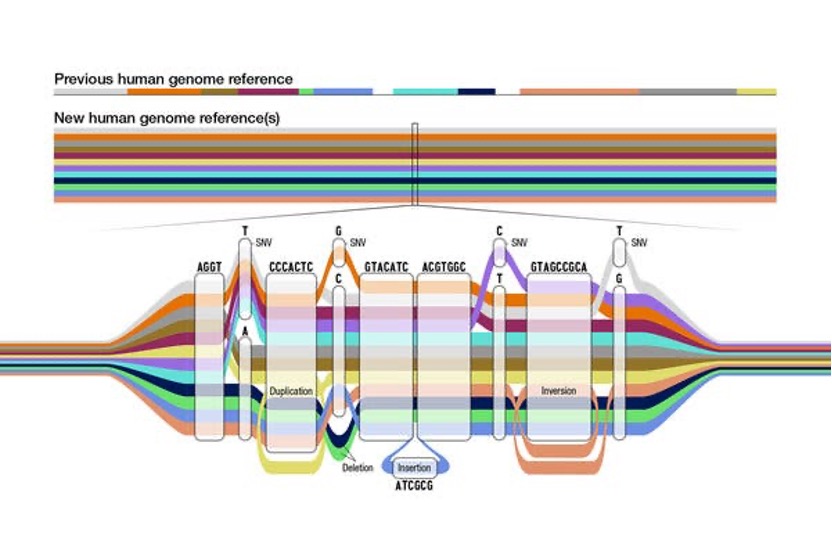The completion of the Human Genome Project (HGP) in 2003 marked the dawn of a new era in life sciences. Just two decades on, mankind’s relentless pursuit of self-understanding has achieved yet another remarkable breakthrough in genomic research with the publication in Nature of a more comprehensive and inclusive edition of the human genetic code.
Dubbed the "pangenome," this new reference incorporates genetic sequences from 47 individuals with diverse ethnic backgrounds, including African Americans, Caribbean Islanders, East Asians, West Africans, and South Americans. The previous reference from the HGP was primarily based on the DNA of one mixed-race individual with inputs from a few dozen other individuals, mostly of European descent.

The new pangenome reference shows many possible routes for a sequence to take, represented by the different colors: Yellow is a duplication variant; pink is an inversion variant; green and blue represent a deletion variant, and light blue is an insertion variant. (Credit: Darryl Leja/NHGRI)
The pangenome, made possible by the latest DNA sequencing technology, fills in the gaps in the previous reference with nearly 120 million previously missing DNA letters, which provides a more detailed understanding of the genetic variations associated with diseases. This knowledge has the potential to revolutionize personalized medicine by enabling scientists and clinicians to develop treatments that benefit individuals of all races, ethnicities, and ancestries.
The project aims to expand the pangenome to include at least 350 high-quality genomes representing the majority of global human diversity, which will allow scientists to explore the wide range of genetic diversity found in human populations worldwide. However, the adoption of this new reference will require the development of new analytical tools and redefining the coordinating systems, which will take time.
As Dr. Eric Green, director of the National Human Genome Research Institute (NHGRI), explained, the pangenome is likened to a comprehensive bodywork manual for automotive repair shops, and the previous reference as only the design specs for one kind of car.
The Human Genome Project
Reflecting on history, none of above would have been possible without the groundbreaking endeavor known as the Human Genome Project (HGP). Recognized as one of the three major scientific projects of the 20th Century, the HGP united researchers from the United States, Britain, France, Japan, Germany, and China in a shared mission to unravel the three billion base pairs comprising the human genome.
China made a significant commitment to the HGP, dedicating resources to sequence, assemble, and analyze approximately 1% of the entire human genome. This work was led by BGI, propelling it to evolve into the world-leading life sciences organization it is today.
On February 15, 2001, Nature unveiled a momentous milestone, publishing a comprehensive draft of the human genome, encompassing over 90% of the DNA base pairs found within our bodies. Ultimately, in 2003, the project was officially declared complete, covering around 92% of the entire human genome sequence. This ambitious undertaking provided unprecedented insights into genetics, diseases, and the realm of personalized medicine, as well as marked a turning point in our understanding of our own genetic blueprint and laid the foundation for the groundbreaking discoveries and advancements that continue to shape our world.

The blueprint of the human genome unveiled by the HGP highlights a fascinating truth: there exists no complete similarity between individual genomes, with an approximate difference of only 0.1%. Recognizing this fact is crucial if we aspire to foster improved outcomes in genomic medicine. It is imperative for the scientific community to address emerging challenges arising from inconsistent results among underrepresented populations.
Addressing this challenge necessitates a comprehensive understanding of the entire spectrum of genetic diversity, which led to the establishment of another significant global collaboration shortly after the HGP – the International Human Genome HapMap Project.
(To be continued in PART 2)



